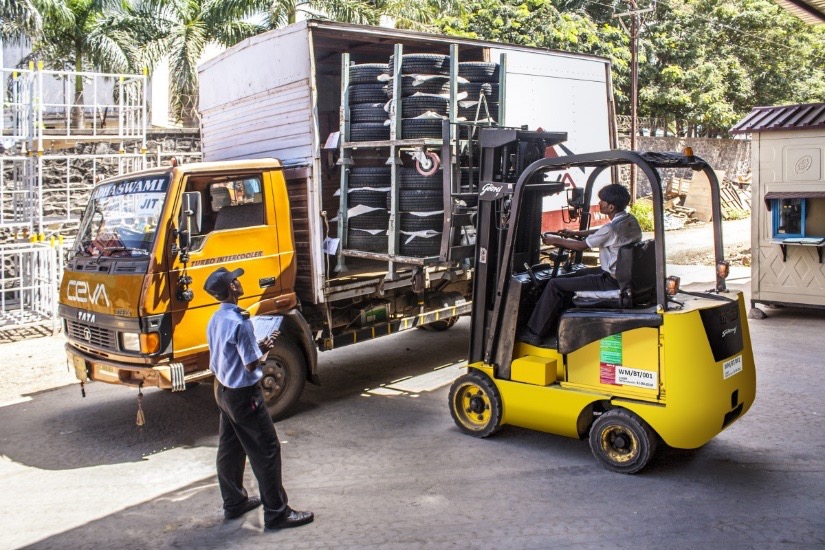Workers at height. Stacked materials. Pedestrian, forklift, and truck traffic.
All in one place.
“Loading docks are very dangerous areas for employees,” said Reginald Jackson, safety and health specialist in the Office of General Industry and Agricultural Enforcement, which is part of OSHA’s Directorate of Enforcement Programs.
Here are five steps to remember:
1. Look at the work area
Hazard assessments, proper work practices and other general safety principles are needed to help keep workers safe when they’re moving and handling equipment.
Employers and employees should work together on a routine to identify – and correct – any unsafe conditions or equipment that are present around the loading dock.
Employers should know and understand the potential hazards associated with the task. Because of the numerous injuries that can result from improper handling and moving of equipment, employers should also be aware of the incidents that have happened in the past. Employers should inform the employees of these types of incidents when they’re first hired and when these incidents occur within their facilities.
2. Apply controls
Workers who move items in or out of trailers can encounter hazards related to ergonomics, lighting, ventilation, noise, and materials. OSHA requires employers to select and provide personal protective equipment based on the hazards present or likely to be present, and to communicate the selection of PPE to its intended users.
Gloves, loading straps (to withstand rough edges and sharp instruments), eye protection, steel-toed shoes or boots, and high-visibility vests are common PPE for workers near loading docks.
PPE should not replace engineering, administrative or procedural controls for safety; they should be used in conjunction with these controls.
3. Prevent falls
Section 1910.28 of OSHA’s standard on walking-working surfaces (1910.22) requires the use of fall protection such as a guardrail system, a safety net or personal fall protection systems if a worker could fall 4 feet or more from an open or exposed dock door or opening.
Guardrail requirements are covered under OSHA 1910.29(b) and its subparts.
These include:
- The top edge height of top rails, or equivalent guardrail system members, are 42 inches (107 cm), plus or minus 3 inches (8 cm), above the walking-working surface. The top edge height may exceed 45 inches (114 cm), provided the guardrail system meets all other criteria of paragraph (b) of this section.
- Midrails are installed at a height midway between the top edge of the guardrail system and the walking-working surface.
- Guardrail systems are capable of withstanding, without failure, a force of at least 200 pounds applied in a downward or outward direction within 2 inches (5 cm) of the top edge, at any point along the top rail.
- Midrails, screens, mesh, intermediate vertical members, solid panels, and other equivalent intermediate members are capable of withstanding, without failure, a force of at least 150 pounds applied in any downward or outward direction at any point along the intermediate member.
When dock doors are not in use or being unloaded, the employer should prevent employees from falling, stepping, or driving off the edge to ensure no one is exposed to that fall.
4. Keep forklifts top of mind
Slow down, look around for other workers, and be mindful of dock edges and wet or icy conditions on surfaces – these are some best practices for forklift operators.
OSHA requirements and recommended practices for forklift operators in loading docks include:
- Maintain a safe distance from the edge of the loading dock.
- Watch out for tail swing (when the rear of the forklift moves to the opposite side of the direction it’s being steered).
- Keep working surfaces clear and clean.
- Paint the edges of the loading dock to improve visibility.
Employers should take note of damaged or weak trailer floors. Trailers should be inspected before forklifts or other material handling devices are allowed to enter.
Workers on loading docks must not only be mindful of what they’re doing, but they also should be aware of the action that’s going on around them, especially when you have forklift drivers and other material handling equipment.
5. Control traffic
With delivery trucks entering and leaving and powered industrial trucks loading and off-loading, high activity levels at loading docks are common. Needed: a traffic control plan to help workers stay safe.
Post speed limits throughout the facility. Keep employee parking lots separate from shipping and receiving areas and help reduce the risk of collisions by prohibiting nonessential employees from high-risk areas where vehicles are maneuvering. Essential workers who are on foot should wear reflective clothing.
Designate employee crossing areas and consider one-way traffic flows or lanes. Mirrors on delivery trucks and forklifts or other powered industrial trucks should be intact and unobstructed, and a spotter should assist when vehicles are backing up.
It’s also important that all workers are aware of the day’s operations schedule. Communication is the key. If employees interact with material handling, forklifts or other materials, everybody should know when these forklifts are moving, where they’re moving and how they’re moving. And the only way that we can do that is to train.
Spencer-SHE has been providing Safety, Health, and Environmental Compliance Guidance since 1980. Our experienced team can evaluate your warehouse safety and training needs to provide cost-effective solutions.
Contact us here to help you to develop and maintain a safe and healthy workforce.
Sources:
https://www.safetyandhealthmagazine.com/articles/23880-loading-docks-5-steps-for-safe-operations
https://www.osha.gov/sites/default/files/publications/OSHA3916.pdf

